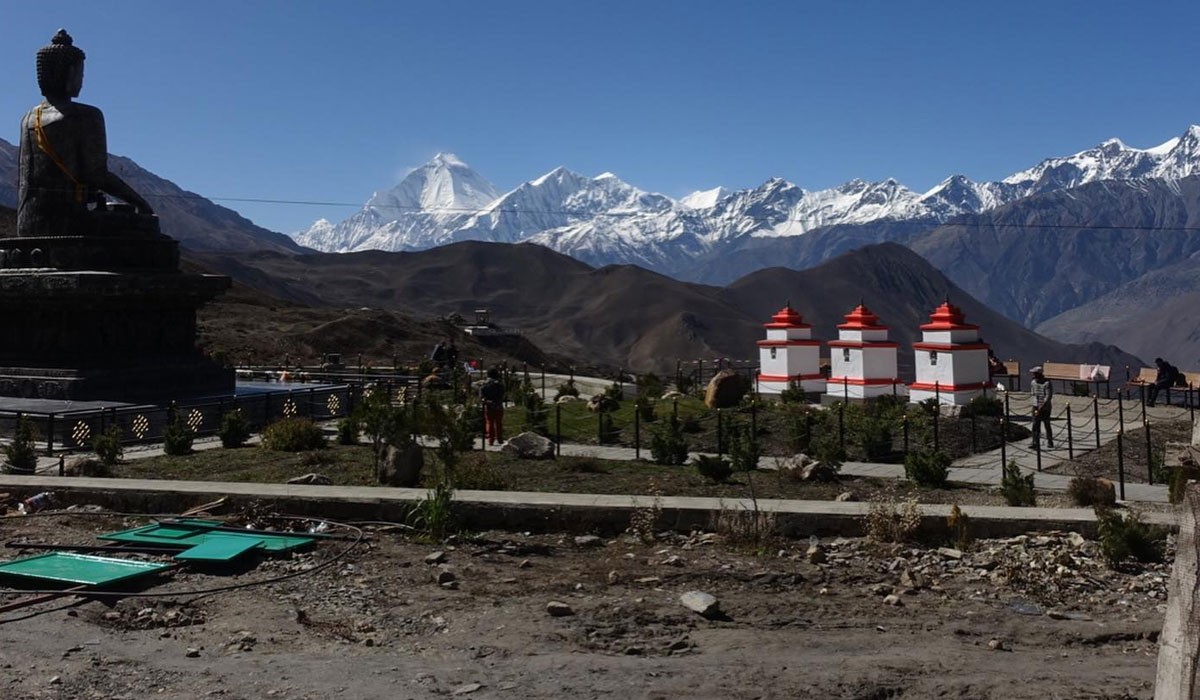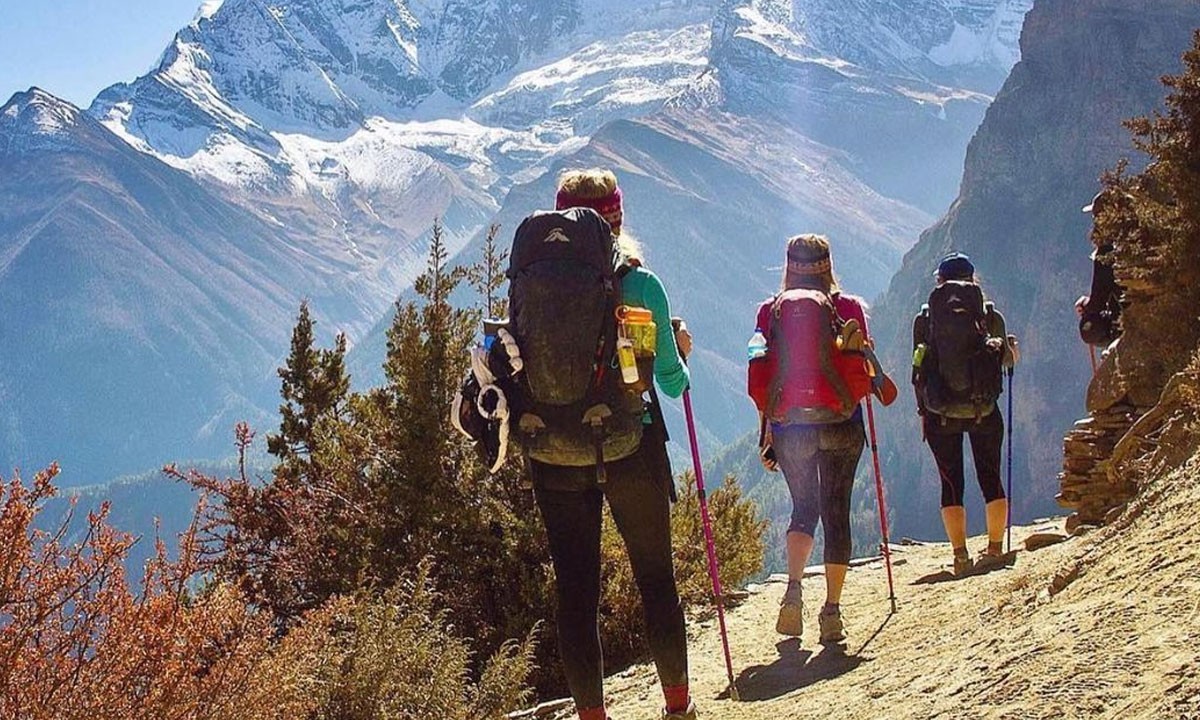Annapurna Circuit Difficulty Level

The Annapurna Circuit Trek has been graded as a ‘moderate’’ Himalayan adventure. Even if you are a complete beginner who doesn’t have any previous high-altitude trekking experience, you will be able to easily do the Annapurna Circuit trek after making the necessary preparations. However, regardless of its moderate difficulty level, Annapurna Circuit is still a Himalayan adventure and nothing like hikes in the backyard, so you shouldn’t slack off during the preparation part.
You will have to overcome several challenging factors as you move along your Annapurna Circuit route. Here are some of the major hurdles of this iconic trekking route that you have to be on the lookout for.
Altitude Sickness
Altitude gain and altitude sickness are considered to be different sides of the same coin; as you gain altitude, the risk of altitude sickness proportionately rises. In this 8 Days Annapurna Circuit Trek, starting your journey from Chame (2,670 meters), you will move along high elevation points like Pisang (3,300 meters), Manang (3,519 meters), Yak Kharka (4,120 meters), Through Phedi (4,560 meters) and the highest altitude jump point of this adventure Thorung La Pass (5,416 meters).
So, as you gain a significant altitude above 2,500 meters (above which there is a risk of altitude sickness), you will have to pay proper attention to the symptoms of altitude sickness.
Trekking Distance
8 Days Annapurna Circuit is an extensive trekking adventure that covers an approximate distance of 160 to 230 km. Although the overall trekking distance depends on the route taken, highlight exploration and side detours to the popular landmarks in the region. You will still cover a significant trekking distance of 6-7 hours on average during each day’s trekking adventure. What elevates the difficulty level of this factor is that long hours of trekking at rising altitudes can be demanding due to the thin air and low oxygen saturation level.
Unpredictable Weather
Although the peak seasons are considered to be the best period for the Annapurna Circuit Trekking due to their favorable weather, the climatic conditions of the high-altitude environment are not always predictable. The high-altitude alpine environment has a climatic zone of its own; it doesn’t take much time for the clear sunny days to be covered by rain and snow clouds. So, you should be prepared for any challenges the climate throws your way.
Similarly, if you are doing the trek in the off seasons like winter (December to February) and monsoon (June to August), the unfavorable weather conditions add further challenges to your hike. Winter season covers your trekking route in snow, the temperature is freezing, and even if the views are rewarding, you have to carry heavy gear and clothes to keep yourself comfortable. Monsoon, on the other hand, is risky due to its slippery trails and natural disasters like flooding and landslides.
Remoteness
This is one of the less talked difficulty factors in the 8 Days Annapurna Circuit. Although many trekkers are excited to undertake one of the most remarkable and iconic Himalayan trekking adventures, what many need to realize is that Annapurna Circuit Trek takes you across to remote and isolated sections of the Himalayas. There aren’t start hotels along the trekking trails, and the accommodation facilities are pretty much basic; electricity and technological development are pretty much limited, and for any kind of health emergency, helicopter rescue is the only viable option. So, ensure you are prepared on every front; it is better to take time with preparation than regret it later.
Is Annapurna Circuit Suitable for Me?

Annapurna Circuit is one of the most rewarding trekking experiences that takes you across the second most popular trekking route in the Himalayas. It is natural for you to wonder if this trek is right for you, considering the difficulty factors. However, the overall trekking difficulty of this iconic route is on the milder side compared to other remote high-altitude adventures. It doesn’t mean that you don’t need to make any preparations for this trek, but an adequate amount of training will be enough.
If you have a basic level of fitness and good health conditions, you will be able to complete this trek without any hassles. But, the comfort level of this remarkable adventure will depend on how much effort you have put into the preparation part. The success rate of the 8 Days Annapurna Circuit is 98%; in the past, even elderly trekkers and children have successfully completed this classical trekking route. So, in the end, it all boils down to how determined you are to do Annapurna Circuit and how much effort you are willing to put into making your journey comfortable and memorable.
How to Tain for This Trek?

For a truly immersive and comfortable experience during your 8 Days Annapurna Circuit, it is recommended that you should prepare at least 4-6 weeks before your trek. Preparing in advance for your Himalayan trekking adventure will get your body accustomed to physical activities; it is especially beneficial if you don’t work out routinely.
For the most effective preparation, you can first assess your physical abilities with some practice hikes or consult a trainer and guide. As you will be trekking for long hours carrying your backpack during each day of your adventure, strength, and endurance exercises will help you buff up your stats. Similarly, cardiovascular training will improve your body’s ability to deliver oxygen to muscles, which also increases your stamina and helps you to acclimatize more efficiently during your trek. Here are some exercises that you can include in your training regime for the Annapurna Circuit.
Strength and Endurance Exercises
- Push up
- Pull up
- Deadlift
- Squat
- Bench press
- Lunge
- Bicep curl
- Plank
- Calf raise
- Overhead press
- Set up
- Broad jump
- Leg extension
Cardiovascular Exercises
- Jogging
- Dancing
- Swimming
- Jumping rope
- Power walking
- Aerobics
- Lateral shuffle
- Burpee
- Mountain climber
- Cardio
Mental Preparation
Besides the physical preparation, it is also important to mentally prepare for the trek. This is especially important if you haven't done any high-altitude remote adventures previously. Mental preparation will keep you motivated, help you stay positive, and deal with the minor discomforts that you may face during your journey. Here are some helpful tips for mental preparation.
- Learn to stay positive regardless of the situation
- Practice meditation
- Stay calm and composed to assess the circumstances properly
- Surround yourself with positive people
- Practice getting out of your comfort zone
- Have low expectations
- Visualize your journey
- Positive self-talking
Food and Accommodation

During the Annapurna Circuit Trek, you will be able to savor tasty delights in your trekking journey. From mouthwatering regional delicacies to Tibetan- Indian culture influences cuisines and popular continental dishes with a Nepali touch, the food exploration prospects are limitless during this trekking adventure. You can expect the following menus at the teahouses during your Annapurna Circuit Trek.
For Breakfast
- Teas, coffee, fresh juice
- Eggs
- Bread or toast with jam, butter, and honey
- Tibetan bread
- Paratha
- Pakoda
- Chapati
- Cornflakes
- Oats
- Pudding
- Fruits
- Muesli
- Pancake
- Pudding
For Lunch and Dinner
- Dal, Bhat, Tarkari (lentil soup, steamed rice, vegetables, and other side dishes)
- Dhido, Gundruk
- Momo/ dumpling
- Chowmein
- Pizza
- Spaghetti
- Pasta
- Macron
- Sandwich
- Fries
- Steak
- Thukpa
- Shyaphale
- Rilduk
- Sherpa stew
**Note: Vegetarian and vegan options are available at the teahouses in the Annapurna region**
Accommodation
The accommodation facilities in the Annapurna circuit trekking route range from moderate to luxurious levels, depending on your trekking package. As this is the second most popular trekking region in the country, the accommodation facilities here are more developed than those of other remote explorations. During your stay at teahouses in this classical route, you can expect a well-furnished room with 2-3 adjacent beds. As for the basic amenities, you will receive a clean sheet, pillow, and warm blanket; the beds are well-patted with comfortable mattresses.
The communal areas like lounges and dining halls are heated at the higher altitudes, and you can share your stories while socializing with other trekkers in the region. As for the bathroom facilities, some teahouses have attached bathroom facilities, while others don’t; in any case, the bathroom will be on a shared basis. For a more personalized experience, you can go for the luxurious or custom-tailored trekking packages.
Packing Checklist

It is important to make sure that you have packed everything that you need for the occasion for a comfortable experience. You will be traversing across different climatic zones during your Annapurna circuit trek, so you need to make sure you have packed all the necessary layers for this classic trek. Although it is recommended to pack light, you don’t want to miss out on the most essentials. Check out the following packing check-list for cross-reference:
For Head and Body
- Sun hat, headscarf
- Wool hat
- Neck gaiter, muffler
- Light, heavy, and waterproof gloves
- Windproof/ lightweight jacket
- Inslualeted/ fleece jacket
- Thermal layers
- Heavy down jacket
- Full sleeve/ half sleeve t-shirts
- Fleece trousers/ pants
- Hiking shorts
- Waterproof/ windproof heavy trousers
For Foot
- Trekking boots
- Waterproof gaiters
- Sports shoes (for short hikes)
- Sandals/ slippers (for resting destinations)
- Different pairs of socks (woolen, thin, thick)
Personal Care/ Hygiene
- Toothpaste, toothbrush, and facewash
- Soaps, shampoo, hair products
- Small mirror and nail clippers
- Lip balm, body lotion, sunscreen protection
- Body deodorants
- Tissues, wet wipes
- Toilet paper
- Hygiene products
- Quick drying towel
- Bug repellent
- Personal medication
- Small first-aid kit
Accessories
- Sleeping bags (four seasonal)
- Duffle bag
- Packing sacks
- Trekking poles
- Ankle support
- Rain cover
- Hydration bladder
- Headlight and extra batteries
- Solar charger, power bank
- Universal charging cord
- Water bottles/ thermos
- Journals, pens
- Card/ board games
- Entertainment set
**Note: Convert the cash to local currency as there are no ATMs on the trekking route. Exchange enough for you to enjoy snacks throughout the trek and in case you might want to buy souvenirs**
You may also like:













